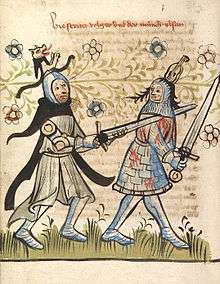Surcoat

A surcoat initially was an outer garment commonly worn in the Middle Ages by both men and women. It can either refer to a coat worn over other clothes or the outermost garment itself. The name derives from French meaning "over the coat", a long, loose, often sleeveless coat reaching down to the feet.[1]
From about the 12th century, knights wore over their armour long, flowing surcoats - frequently emblazoned with their personal arms - that usually extended to about midcalf, had slits in the bottom front and back, thus allowing the wearer to ride comfortably and were either sleeved or sleeveless. Historians believe that the practice of wearing white ones was adopted during the Crusades, their main purpose of reflecting the direct sun, which overheated it (and the soldier inside); while in poor weather they helped keep rain and the muck of battle away from the easily corroded mail links; although it may be argued that here its color would have been of little help. The surcoat displayed the device of the knight (origin of the term "coat of arms") thus identifying him; which in turn, combined with the increased use of the great helm (late 12th century, early 13th century) became an essential means of recognition. Indeed, some historians cite this as one of the reasons behind the spread of heraldry across medieval Europe. During the 13th century, knights began to add plates of armour to their surcoats, that subsequently became the medieval coat of plates. In the early fourteenth century, the front of the knight's surcoat was shortened, so that it was longer at the back, knee-length at the front; thus allowing greater freedom of movement, and eliminating the danger of a rider getting his spurs caught in the garment. By the mid-fourteenth century it was replaced with the "jupon" (or "gipon"), a much shorter item, often padded for supplementary protection.[2]
In the 15th century, once suits of plate armour became common, the surcoat was phased out of use. The period in the history of armour development, in which surcoats became increasingly rare, is referred to as the "surcoatless period" (1420-1485).
See also
Footnotes
- ↑ Nunn, pp. 14, 23, 24, 28
- ↑ Farr, E.; et al. (1873). The National History of England. 1. London & Glasgow: William Collins, Sons & Company. Retrieved 2011-04-06.
Sources
- Nunn, Joan, Fashion in costume, 1200-2000, New Amsterdam Books, 2000, ISBN 1-56663-279-X